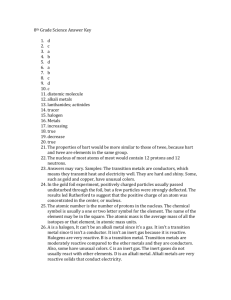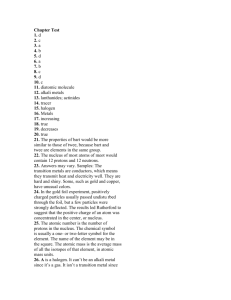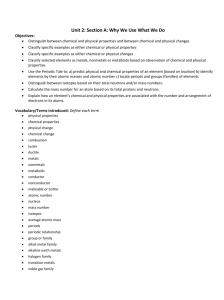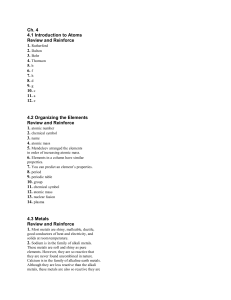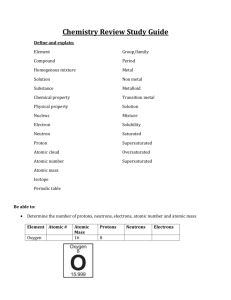and View
advertisement
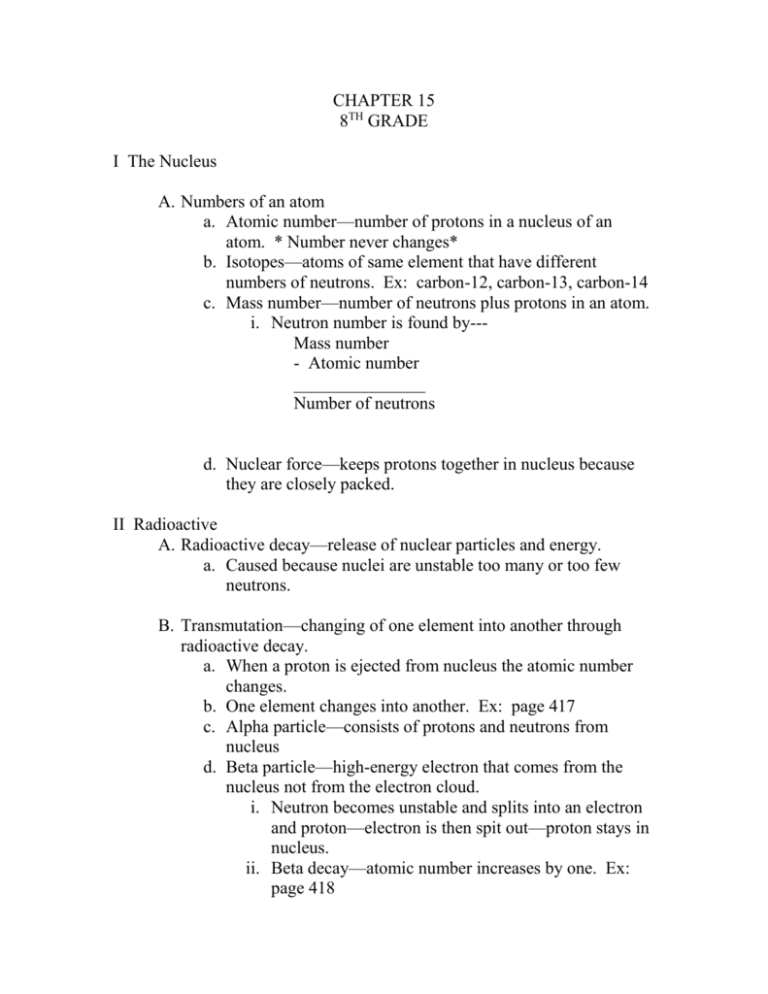
CHAPTER 15 8TH GRADE I The Nucleus A. Numbers of an atom a. Atomic number—number of protons in a nucleus of an atom. * Number never changes* b. Isotopes—atoms of same element that have different numbers of neutrons. Ex: carbon-12, carbon-13, carbon-14 c. Mass number—number of neutrons plus protons in an atom. i. Neutron number is found by--Mass number - Atomic number _______________ Number of neutrons d. Nuclear force—keeps protons together in nucleus because they are closely packed. II Radioactive A. Radioactive decay—release of nuclear particles and energy. a. Caused because nuclei are unstable too many or too few neutrons. B. Transmutation—changing of one element into another through radioactive decay. a. When a proton is ejected from nucleus the atomic number changes. b. One element changes into another. Ex: page 417 c. Alpha particle—consists of protons and neutrons from nucleus d. Beta particle—high-energy electron that comes from the nucleus not from the electron cloud. i. Neutron becomes unstable and splits into an electron and proton—electron is then spit out—proton stays in nucleus. ii. Beta decay—atomic number increases by one. Ex: page 418 III Rate of Decay A. Not predictable when decay will begin. B. Half-life—amount of time it takes for half of a sample of the element to decay. IV Calculating half-life A. Number of years / half-life of the element = number of half-lives B. Initial weight / (number of half-lives) = final weight C. Page 419 I Using Radioactivity A. Carbon dating—determining age of artifacts and fossils. a. Carbon 14 used for this. b. Test to see amount of Carbon 14 left in the organism—tells age B. Waste disposal a. Special sites used because after decay radiation still exists b. Buried deep underground. II Making synthetic elements A. Not all elements occur naturally. B. Atom smashing creates new elements. C. Ex: 93,112,114 are synthetic. III Uses of Radioactive Isotopes A. Can be used in hospitals and clinics. B. Tracer elements used to diagnose disease and study environmental conditions. C. Radioactive iodine used to detect problems of thyroid. D. Technetium-99—used for tracing a variety of body processes— Tumors, fractures. E. Environmental uses to detect problems in plants—phosophorus-32 and how they use fertilizers and pesticides. I Introduction to Periodic Table A. 1830—55 different elements had been isolated and named. a. Mendeleev, Russian chemist in 1869,-arranged elements in order of mass. i. Found elements of similar properties grouped together. b. Moseley, English physicist, rearranged by elements by atomic number instead of atomic mass. i. Showed many elements were missing. II Modern Periodic Table A. 7 periods—rows of elements whose properties change gradually and predictably. B. 18 groups---columns with family of elements having similar properties both physical and chemical. C. Group 1 and 2, 13 to 18—representative elements. a. Metals b. Nonmetals c. Metalloids D. Group 3 to 12—transition elements. a. Metals III Types of Elements A. Metal—luster, conducts heat, and conducts electricity, is malleable and ductile. B. Nonmetals—gases or brittle solids at room temperature. C. Metalloids—has properties of metals and nonmetals. D. Inner transitional metals—below main table called lanthanide and actinide –named after beginning element. IV Metals A. Luster—ability to reflect light. B. Malleable—shaped into different shapes. C. Ductile—can be made into wire. D. High melting point. E. Solids except for mercury. V Nonmetals A. Gases or brittle solids. B. Poor conductor of heat and electricity. C. 17 on the periodic table. VI Metalloid A. Share properties of metals and nonmetals. B. Also called semimetals. VII Element Keys A. Boxes on periodic table. B. Tells you--a. Name of the element. b. Atomic number—number of protons in the atom. c. Symbol—abbreviation of the name. (Greek, Latin, or Location) d. Atomic mass—mass of protons with neutrons. C. IVPAC—organization that chooses permanent name for element. SECTION 2 I Representative Elements A. Group 1 and 2 are active metals found in nature combined with other elements. a. Hydrogen is group 1—not metals and fits the properties of 1 and 17. b. Alkali metals—silvery solids with low densities and low melting points—increase in reactivity from top to bottom of periodic table. i. Potatoes, batteries, salt. c. Alkali earth metals—denser, harder, high melting points, less reactive of alkali in the same period. B. Group 13 – 18 can be metals, nonmetals, or metalloids that are solid, liquid, and gases. a. Group 13—Boron family i. All metals except boron, which is a metalloid, used in variety of products. Ex: cookware, aluminum, siding. b. Group 14---Carbon family i. All metals and metalloids, except carbon. 1. Carbon found in all living things. 2. Silicon and germanium are used in electronics as semiconductors. 3. Tin and lead are heaviest in group 14. c. Group 15---Nitrogen family i. Nitrogen and phosphorus needed by living things and industry. 1. 80% of air is Nitrogen. 2. Nitrogen gets in body through eating plants. d. Group 16---Oxygen family i. Contains oxygen and sulfur, which is needed for life, used to make many products. 1. 20% Earth air is oxygen. 2. Ozone, combustion, soil. 3. Sulfur—sulfuric acid. e. Group 17---Halogen family i. Elements from salt, sodium, and other alkali metals. ii. Halogens are “salt formers”. iii. Very reactive elements. f. Group 18---Noble gases family i. Rarely combine with other elements and are found uncombined in nature. 1. Balloons (helium) 2. Lighting 3. Glows different colors when electricity runs through it. SECTION 3 I Transition Elements A. Groups 3 – 12 are transition elements. a. Most combine with other elements in ores. b. Iron triad—includes iron, cobalt, nickel. They are magnetic when put together. c. Catalysts—substances that make chemical reactions occur without changing themselves. B. Inner Transition Elements a. Lanthanides—soft minerals once thought to be rare. b. Actinides—radioactive, synthetic elements—do not occur naturally. II Dentists A. Did use amalgam to make dental fittings—has mercury in them. Ex: fillings, bridges. B. Today—they use composites, resins, and porcelain. C. Nickel and titanium now used for braces—heat-treated keep shape—memory wire.

